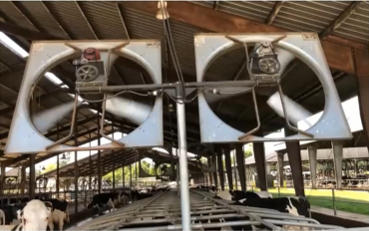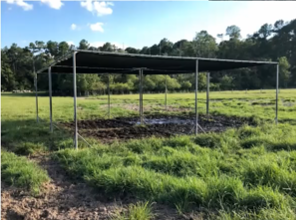Managing heat stress in heifers: Protecting performance from calf to cow
Understanding how heat stress affects youngstock, in-utero and beyond and implementing targeted cooling and nutrition strategies can help producers safeguard both current and future herd performance.

Heat stress isn’t just a summer inconvenience, it’s a serious challenge that affects heifers at every stage of development, from gestation through pregnancy. As highlighted by Bethany Dado Senn, Calf and Heifer Technical Specialist with Vita-Plus Corporation, the impacts of elevated temperatures go far beyond short-term discomfort. Left unmanaged, heat stress can reduce growth, weaken immunity, impair reproduction and even diminish lifetime productivity across generations. Understanding how heat stress affects youngstock, in-utero and beyond and implementing targeted cooling and nutrition strategies can help producers safeguard both current and future herd performance.
Heat stress starts earlier and lasts longer than you think
A heifer’s vulnerability to heat stress begins before she’s even born. The thermal neutral zone, the range where calves and heifers aren’t expending extra energy to stay cool, varies based on age, breed, housing and climate. For many animals, heat stress can start to take hold with temperatures as low as 65 degrees Fahrenheit, especially when humidity is high. The Temperature Humidity Index is a tool that combines air temperature and relative humidity to quantify heat stress in cattle. During heat stress, heifers divert energy away from growth, immunity, and reproduction to focus on cooling themselves, reduced feed intake, heightened metabolic strain, and long-term setbacks.
When dry cows or pregnant heifers experience heat stress, their calves pay the price. Research shows that, when compared to calves without in utero heat stress exposure, calves exposed to heat stress in utero are born with:
- Lower birth weights and reduced average daily gain (ADG) during 0 to 63 days of age
- Reduced immune organ development
- Diminished milk duct proliferation and reduced milk producing tissue
These early disadvantages lead to measurable losses in future productivity, including:
- 5–14 lbs./day less milk in the first three lactations
- Shorter herd longevity by up to 300 days
- Granddaughters of heat-stressed cows show reduced mammary development and lifetime milk yield
The clear takeaway? Cooling dry cows and pregnant heifers is essential for protecting both current calves and future generations. Shade and fans are a must in the Midwest, with soakers recommended for hotter climates. Partial cooling efforts aren’t enough and once prenatal damage is done, postnatal interventions can’t reverse it.


Preweaned calves: Small bodies, big risks
Young calves are especially susceptible to heat stress, which can lead to decreased milk and starter intake, lower weaning weights, higher respiratory rates and body temperatures and weakened immune responses with increased BRD (bovine respiratory disease) cases. Producers should monitor for early signs of heat stress such as elevated respiration rates: 40 breaths per minute (bpm) indicates discomfort, while 60 bpm signals clinical heat stress. Simple interventions like ensuring hutches shade and passive ventilation (e.g., propping hutches or using shade cloth) can dramatically improve calf comfort without significant investment. While passive ventilation works well in cooler regions, active ventilation (fans or tubes) may be necessary in hotter areas.
Bethany’s data suggests:
- Plastic hutches with shade outperform other setups
- Indoors may offer cooler conditions, but calf physiology doesn’t always improve without airflow management
- Ensure 11–20 square feet of shade per calf using durable materials
When introducing a new system for heat mitigation, regular evaluation of the system and its effectiveness is advised. The Michigan State University Extension dairy team can provide heat stress assessments to assist with this.
Nutrition: Keep it balanced and fresh
Heat-stressed calves and heifers naturally reduce their feed intake, but drastic ration changes aren’t always the answer. For preweaned calves, stick to consistent feeding volumes and prioritize hydration, offering lukewarm water shortly after milk feedings and use electrolytes proactively before heat waves. Inspect starter grain daily for signs of mold and spoilage.
For post-weaned heifers, adjust rations only after observing intake drops. This may include reducing NDF slightly or enhancing trace minerals like sodium, potassium, and magnesium to support heat resilience. Older heifers often suffer silently through summer, with impacts including reduced ADG and feed efficiency, higher body fat, altered rumen fermentation, decreased reproductive efficiency (weaker estrus, lower ovulation rates) and increased risks of subclinical mastitis and parasite infestation.
Late-gestation heifers face the same risks as dry cows when exposed to heat stress, including reduced milk production potential in their calves and compromised passive transfer. Bethany recommends treating pregnant heifers with the same priority: Provide shade, ventilation and soakers where needed and pay particular attention to sexed semen pregnancies, as these represent the genetic future of the herd.
Proactive heat stress management pays long-term dividends
Heat stress is a silent thief, robbing growth, health and productivity at every stage of the heifer lifecycle. By focusing on:
- Cooling dry cows and pregnant heifers
- Implementing shade and ventilation for calves and heifers
- Maintaining balanced nutrition with quality hydration
- Identifying early warning signs like respiration rate and posture
Producers can protect both immediate performance and future herd potential. As Bethany Dado Senn emphasized, managing heat stress isn’t just about surviving the summer, it’s about caring for cattle of all ages today to secure long-term success across generations.



 Print
Print Email
Email